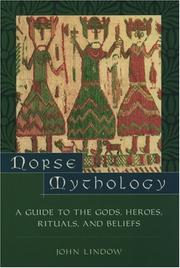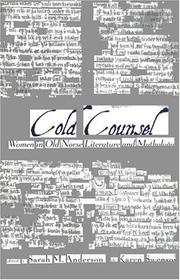| Listing 1 - 10 of 14 | << page >> |
Sort by
|
Book
ISBN: 0585427321 9780585427324 Year: 2000 Publisher: [Coral Gables, Fla.] Opera Journeys
Abstract | Keywords | Export | Availability | Bookmark
 Loading...
Loading...Choose an application
- Reference Manager
- EndNote
- RefWorks (Direct export to RefWorks)
A comprehensive guide to Wagner's THE VALKYRIE (Die Walküre), featuring Principal Characters in the opera, Brief Story Synopsis, Story Narrative with Music Highlight Examples, and an insightful and in depth Commentary and Analysis by Burton D. Fisher, noted opera author and lecturer.
Fisher, Burton D. --- Nibelungen -- Drama. --- Valkyries (Norse mythology) -- Drama.
Book
ISBN: 0199948623 9780199948628 9780199369850 0199369852 9780199948611 0199948615 019937130X Year: 2013 Publisher: New York
Abstract | Keywords | Export | Availability | Bookmark
 Loading...
Loading...Choose an application
- Reference Manager
- EndNote
- RefWorks (Direct export to RefWorks)
This is a study of the evidence in art, artifact, architecture, and poetry that the myth of Yggdrasil, the cosmic tree of life associated with the gods, the runes, fate, and ragnarok in Norse/Germanic mythology, was associated in northern Christianity with the cross of Christ. The events of the story of Yggdrasil were seen as a kind of foreshadowing for the events in the New Testament, especially the crucifixion and resurrection, and the ultimate salvation of human beings from death and their corpses from the Nidhogg.
Christianity and other religions --- Mythology, Norse. --- Yggrasil (Norse mythology) --- Norse.
Book
ISBN: 1350137111 135013712X Year: 2020 Publisher: London [England] : [London, England] : Bloomsbury Academic, Bloomsbury Publishing,
Abstract | Keywords | Export | Availability | Bookmark
 Loading...
Loading...Choose an application
- Reference Manager
- EndNote
- RefWorks (Direct export to RefWorks)
"Valkyries: the female supernatural beings that choose who dies and who lives on the battlefield. They protect some, but guide spears, arrows and sword blades into the bodies of others. Viking myths about valkyries attempt to elevate the banality of war - to make the pain and suffering, the lost limbs and deformities, the piles of lifeless bodies of young men, glorious and worthwhile. Rather than their death being futile, it is their destiny and good fortune, determined by divine beings. The fateful agency of women is widespread in Norse sources. Norse sagas and Viking myths tell stories of war and strife, loyalty and betrayal, murder and revenge, privation and success. The women in these stories take full part in the power struggles and upheavals in their communities and families, for better or worse. But in some spheres, women are systematically oppressed or excluded because of their gender, and the sagas communicate heartbreaking stories of girls' and women's traumatic experiences that resonate strongly today. Valkyrie will introduce readers to the dramatic and fascinating texts recorded in medieval Iceland, a culture able to imagine women in all kinds of roles carrying power, not just in this world, but pulling the strings in the other-world, too. Drawing on the latest historical and archaeological evidence, this book will also uncover the reality behind the myths and legends to reveal the dynamic, diverse lives of Viking women."--
Women, Viking --- Women --- Valkyries (Norse mythology) --- History. --- History
Book
ISBN: 2757419110 2757401203 Year: 2017 Publisher: Villeneuve d'Ascq : Presses universitaires du Septentrion,
Abstract | Keywords | Export | Availability | Bookmark
 Loading...
Loading...Choose an application
- Reference Manager
- EndNote
- RefWorks (Direct export to RefWorks)
Les poèmes mythologiques et héroïques, la version en prose de Snorri Sturluson (le plus grand écrivain et mythographe islandais du Moyen-Âge, 1178-1241) de l’Edda sont les sources littéraires de cette étude mythologique. Chaque dieu est présenté avec ses attributs et ses fonctions à la faveur des textes qui le concernent et des mythes qui s’y rattachent sans faire l’impasse sur les incertitudes et les doutes de la recherche passée et actuelle. S’étendant sur 2 500 ans et sur un espace vivifié par les Vikings qui va du Groenland à Constantinople, du Nord de la Suède à Gibraltar, ce corpus de croyances païennes offre naturellement de singulières distorsions et présente cependant de confondantes continuités thématiques. À l’aide de l’archéologie, l’histoire, la littérature, l’onomastique et la linguistique, entre autres sciences, cet ouvrage fait non seulement le point sur les connaissances actuelles, mais encore bat en brèche certaines interprétations traditionnelles qui voudraient privilégier le côté martial alors que la civilisation où s’est développée cette mythologie a pour trait fondamental la troisième fonction dumézilienne.
Gods, Norse. --- Mythology, Norse. --- Mythology, Scandinavian --- Norse mythology --- Scandinavian mythology --- Norse gods --- runes --- Moyen-Âge --- mythologie --- Edda --- religion --- viking

ISBN: 1280532491 0198034997 1429402261 9780198034995 9786610532490 6610532494 9780195153828 0195153820 9781280532498 9781429402262 0199839697 0197725511 9780199839698 Year: 2002 Publisher: Oxford ; New York : Oxford University Press,
Abstract | Keywords | Export | Availability | Bookmark
 Loading...
Loading...Choose an application
- Reference Manager
- EndNote
- RefWorks (Direct export to RefWorks)
'Norse Mythology' explores the magical myths and legends of Norway, Sweden, Denmark, Iceland and Viking-Age Greeland - outlining along the way the prehistoric tales and beliefs from these regions that have remained embedded in the imagination of the world.
Mythology, Norse. --- Northmen --- Mythology, Scandinavian --- Norse mythology --- Scandinavian mythology --- Religion. --- Old Norse literature --- Icelandic literature --- History and criticism.

ISBN: 0203775147 1134821387 9781134821389 9780203775141 0815319665 9780815319665 9781134821525 1134821522 9781134821457 113482145X 9781138991460 1138991465 Year: 2002 Publisher: New York
Abstract | Keywords | Export | Availability | Bookmark
 Loading...
Loading...Choose an application
- Reference Manager
- EndNote
- RefWorks (Direct export to RefWorks)
Cold Counsel is the only collection devoted to the place of women in Old Norse literature and culture. It draws upon the disciplines of history, sociology, feminism, ethnography and psychoanalysis in order to raise fresh questions about such new subjects as gender, class, sexuality, family structure and ideology in medieval Iceland.
Old Norse literature --- Mythology, Norse. --- Women in literature. --- Woman (Christian theology) in literature --- Women in drama --- Women in poetry --- Mythology, Scandinavian --- Norse mythology --- Scandinavian mythology --- History and criticism.
Book
ISBN: 1947447017 1947447009 9781947447011 Year: 2017 Publisher: Brooklyn, NY punctum books
Abstract | Keywords | Export | Availability | Bookmark
 Loading...
Loading...Choose an application
- Reference Manager
- EndNote
- RefWorks (Direct export to RefWorks)
What do medieval Icelanders mean when they say “troll”? What did they see when they saw a troll? What did the troll signify to them? And why did they see them? The principal subject of this book is the Norse idea of the troll, which the author uses to engage with the larger topic of paranormal experiences in the medieval North. The texts under study are from 13th-, 14th-, and 15th-century Iceland. The focus of the book is on the ways in which paranormal experiences are related and defined in these texts and how those definitions have framed and continue to frame scholarly interpretations of the paranormal. The book is partitioned into numerous brief chapters, each with its own theme. In each case the author is not the least concerned with how the paranormal functions within medieval society and in the minds of the individuals who encounter and experience it and go on to narrate these experiences through intermediaries. The author connects the paranormal encounter closely with fears and these fears are intertwined with various aspects of the human experience, including gender, family ties, and death. The Troll Inside You hovers over the boundaries of scholarship and literature. Its aim is to prick and provoke but above all to challenge its audience to reconsider some of their preconceived ideas about the medieval past.
Norse religion & mythology --- Old Norse literature. --- Supernatural in literature. --- Trolls. --- Trulls --- Fairies --- Icelandic and Old Norse literature --- Old Norse literature --- History and criticism. --- medieval mythology --- Iceland --- monster theory --- trolls --- Norse mythology
Book
ISBN: 1282414267 9786612414268 1443815136 9781443815130 Year: 2009 Publisher: Newcastle upon Tyne, UK : Cambridge Scholars Pub.,
Abstract | Keywords | Export | Availability | Bookmark
 Loading...
Loading...Choose an application
- Reference Manager
- EndNote
- RefWorks (Direct export to RefWorks)
Myth presents the latest interdisciplinary research by graduate students in the fields of German and Scandinavian studies, compiling papers that were introduced at the eponymous 2008 graduate student conference at the University of Massachusetts Amherst. Focusing on myths in and about German and Scandinavian societies, these essays provide exemplary analyses of how cultural and social practices mutually inform and influence each other. This anthology is primarily intended for scholars acros...
Mythology, Germanic --- Mythology, Norse --- Folklore --- Folk beliefs --- Folk-lore --- Traditions --- Ethnology --- Manners and customs --- Material culture --- Mythology --- Oral tradition --- Storytelling --- Mythology, Scandinavian --- Norse mythology --- Scandinavian mythology --- Germanic mythology --- Mythology, Teutonic --- Teutonic mythology
Book
ISBN: 9780813942285 0813942284 9780813942261 0813942268 9780813942278 0813942276 Year: 2019 Publisher: Charlottesville
Abstract | Keywords | Export | Availability | Bookmark
 Loading...
Loading...Choose an application
- Reference Manager
- EndNote
- RefWorks (Direct export to RefWorks)
"This book explores the role of apocalypse in Old Norse mythology and literature, relating it to the threat of ecological catastrophe today"--
Environmental disasters. --- Apocalypse in literature. --- Disasters in literature. --- Mythology, Norse. --- Old Norse literature --- Mythology, Scandinavian --- Norse mythology --- Scandinavian mythology --- Eco-disasters --- Ecological disasters --- Disasters --- Ecological disturbances --- History and criticism.
Book
ISBN: 9048554063 9463729054 Year: 2021 Publisher: Amsterdam : Amsterdam University Press,
Abstract | Keywords | Export | Availability | Bookmark
 Loading...
Loading...Choose an application
- Reference Manager
- EndNote
- RefWorks (Direct export to RefWorks)
Myth and History in Celtic and Scandinavian Traditions explores the traditions of two fascinating and contiguous cultures in north-western Europe. History regularly brought these two peoples into contact, most prominently with the viking invasion of Ireland. In the famous Second Battle of Mag Tuired, gods such as Lug, Balor, and the Dagda participated in the conflict that distinguished this invasion. Pseudohistory, which consists of both secular and ecclesiastical fictions, arose in this nexus of peoples and myth and spilled over into other contexts such as chronological annals. Scandinavian gods such as Odin, Balder, Thor, and Loki feature in the Edda of Snorri Sturluson and the history of the Danes by Saxo Grammaticus. This volume explores such written works alongside archaeological evidence from earlier periods through fresh approaches that challenge entrenched views.
Mythology, Celtic. --- Mythology, Norse. --- History --- Celtic. --- Scandinavian. --- Annals --- Auxiliary sciences of history --- Mythology, Scandinavian --- Norse mythology --- Scandinavian mythology --- Celtic mythology --- Celts --- History. --- Scandinavia --- Mythology, Vikings, Irish Pagan Gods, Saxo Grammaticus, Snorri Sturluson.
| Listing 1 - 10 of 14 | << page >> |
Sort by
|

 Search
Search Feedback
Feedback About UniCat
About UniCat  Help
Help News
News